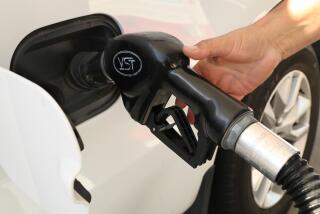Saying ‘Fill ‘er Up’ Can Be Costly at the Gas Station
It was chilly, she was nicely dressed and she thought her car might need oil: reasons enough for Elva Nunez, 25, to pay an extra 30 cents a gallon the other day for the luxury of having someone else fill her car’s gasoline tank.
“I’ve tried doing it myself and I don’t like it. I don’t like the smell on my hands,” the Alhambra woman said. “And I don’t know much about cars. I don’t mind paying the price if I know the car will get taken care of.”
Customers like Nunez are a godsend to gasoline dealers, who, over the last year, have sharply increased the price spread between fuel pumped by customers and that dispensed by attendants.
A recent study by the Los Angeles-based Lundberg Survey found that the gap, which had been slowly widening since the self-serve phenomenon took hold in the mid-1970s, leaped by nearly 40% last year to an average of 29 cents a gallon.
In some cases, premiums of 60 cents a gallon or more have been reported--nearly doubling the overall price--for a service that analysts say costs dealers as little as a nickel per gallon to perform.
Many ‘Never Check’
The roughly 20% of motorists who prefer to be pampered at the pumps are a breed that has shown a willingness to pay almost anything to avoid wrestling with smelly, cumbersome gasoline hoses. Although Nunez said she knows what it costs her, dealers say many customers just look the other way.
George Gulesserian, owner of a Chevron station in South Pasadena, did not want a reporter to talk with his full-service customers for fear that it would call their attention to the higher prices. “I don’t want them to be reminded. Seventy percent of them never check,” Gulesserian said.
In Long Beach, dealer and wholesaler Ron Appel said an occasional customer will pull up to the full-service islands and try to pump his own gas, apparently oblivious to the system of marketing that has emerged over the years.
This might not qualify as price gouging; in most cases the customer voluntarily pays the higher price. It is, however, increasingly a boon to the dealer.
“It’s extremely profitable, far more so than is necessary to recover the cost of providing full service,” said Scott T. Jones, vice president at Chase Econometrics in Bala-Cynwyd, Pa., a one-time economist at Atlantic Richfield. “They’re taking advantage of the fact that the full-service customer is extremely insensitive to price.”
The advent of the self-service pump is an important part of the dramatic change that has swept the American gasoline station since oil prices surged in 1973. Longstanding prohibitions on grounds of fire safety were quickly erased and energy-shocked motorists began climbing out of their cars to pump their own gas. For most, it was a minor inconvenience that saved both money and time.
Free Labor
For the oil companies, it was a chance to sell more gasoline with fewer workers. Analysts say the self-service islands can process 30% to 40% more gasoline than the attended islands because each motorist contributes a few moments of free labor and several cars are taken care of at the same time. At the other pumps, cars sit idly waiting for an attendant.
Over the last 14 years, self-serve gasoline has grown to account for about 80% of all sales--and 85% in California. Nervousness about what the marketing experts called the “lady factor” largely vanished: The industry says 70% of women motorists pump their own gas and 85% of men.
The marketplace has made it increasingly worth the trouble. What was a price advantage of about 2 cents a gallon at the self-serve island in 1979 edged up to an average of about 7 1/2 cents a gallon by 1982.
Given new flexibility by the decontrol of gasoline prices that took effect in 1981, gasoline retailers began trimming profit margins at the self-service island and fattening them at full-service pumps, academic researchers said. And as prices overall began to soften at about that time because of declining crude oil prices, the price differential between full- and self-serve gasoline grew to about 21 cents by the end of 1985.
A 29-Cent Gap
Then, according to a recent study by the Lundberg Survey, when the price of crude oil suddenly collapsed a year ago and gasoline prices followed, the full-serve price fell 19% while self-serve prices dropped nearly 30%. By the end of 1986, the gap between full- and self-serve prices stood at an average of 29 cents a gallon.
Jones said that over the years, the effect for the majority of motorists has been to lower prices perhaps 10 cents a gallon below what they would be if there were no self-service islands.
To explain the gap in price between full- and self-serve, dealers sketch a scenario that faintly resembles the way car salesmen and others bargain with consumers: If the dealer comes down $100 on price, he gets it back on the trade-in or some other piece of the transaction. In the end, he collects the same margin.
In the gas station business, dealers establish a “pooled margin”--the profit margin to be wrung from a shipment of gasoline. The price spread between self-serve and full-serve and between cash and credit sales will be juggled to respond to the competition down the street and the general demand for gasoline.
The lower profit margins at the self-serve pump and the higher margins of full-serve will yield the overall profit margin for a station, margins that last year reached “astronomical” levels before competition beat them down to the 10-cent-a-gallon range, according to Jones.
Imbalance Worsens
When there is big pressure to sell more gasoline--which there was last year as the big oil producers leaned on gasoline sales to ease the losses they incurred when the price of crude oil collapsed--the imbalance is bound to worsen.
“The majors might tell you to do 100,000 gallons a month or lose your lease,” said Appel, owner of United Oil Co., a gasoline wholesaler who owns several Atlantic Richfield and other major brand stations. “So you cut your margins on the 80,000 gallons you sell at self-serve, and to make up for it you raise the margins on the 20,000 gallons of full-serve.”
Trilby Lundberg, publisher of the Lundberg Survey, said, “The spread is a direct result of what seems to be required to keep the pooled margin in the black.”
The refiners’ influence on pump prices is not a subject that the oil industry is eager to discuss, except to insist, as did pricing supervisor James Huccaby of Chevron USA, “We don’t have any control over how the dealer sets his full- or self-serve prices. . . . In any meeting we have with dealers, the last statement we make is always, ‘The price on the street is your decision.’ ”
Dealers, who tend to view the self-serve customer as one devoid of station loyalty, who gets his lube job and microwave sandwich somewhere else, blame Big Oil for squeezing them so tightly on the wholesale price that they have no choice but to collect a fat margin from the motorist who would rather be pampered.
‘Mini-Serve’ Islands
“Full-serve subsidizes the self-serve island,” said Al Ricci, assistant executive director of the Southern California Service Station Assn. “And those 50-cent spreads push more people to self-serve.”
Dealer groups in Oregon and New Jersey have managed to defeat efforts to lift longstanding prohibitions against self-service stations, leaving those states with so-called “mini-serve” islands where the attendant pumps the gas but does nothing else. Low per-gallon state taxes have tended to offset the higher margins collected by the dealers.
Actually, “mini-serve” is what motorists will find at some supposed full-serve islands, where attendants will do little more than pump the gas. In some cases, the price might be slightly lower than at the genuine full-serve operation across the street, but dealers say such minimal service is less likely to reflect station policy than lazy attendants.
“They don’t always do what you want them to do,” said Ed Outlaw, manager of Lou Bacca Chevron in Santa Ana. “When I broke into this business, we used to do it all. We used to carry a whisk broom around. But today when you quit watching them, they might not do what they’re supposed to do, which is wash all the windows, check under the hood, check the tires, empty the ashtrays and so forth.”
In a climate of declining overall prices, the hefty price gap has not caused much of an uproar, even among those for whom full service is a virtual necessity.
Two Letters a Month
“I get about two letters a month complaining about this,” said Lou Keezing, energy specialist for the American Assn. of Retired Persons in Washington.
In California and nine other states, the handicapped are protected by laws requiring service stations to pump their gasoline at the cheaper self-service pumps. State officials said that the rare violations invariably turn out to be the result of uninformed station attendants. In the rest of the country, dealers are urged by the American Petroleum Institute to do this voluntarily.
“The trouble with (the pricey full-service pumps) is the people who can afford it least, the elderly and infirm, are the ones who have to use it,” Ricci said. “To me, that’s just unfair.”
“It is regressive in that respect,” Jones said. “When the elderly pull up to the pump, for them it’s like the equivalent of a very heavy sales or use tax. But prices are going in the right direction, so no one cares.”
The average full-service price nationally for regular unleaded gasoline fell to $1.10 last month from $1.37 a year earlier, according to the Lundberg Survey, part of an estimated $25-billion savings to motorists last year in lower gasoline prices.
As prices have begun climbing since the first of the year, the gap between full-serve and self-serve has narrowed by a penny or so. Lundberg said, however, that the spread is probably permanently larger, raising the question of whether more and more able-bodied motorists will eventually decide that it is not worth it and the elderly will react against it more strongly.
‘Reap the Whirlwind’
This pricing strategy “could reap the whirlwind in long-term motorist exodus due to wide service differentials,” the Lundberg study says.
As for the elderly, Charles Fleming of the California Department of Rehabilitation said that anyone who is physically unable to handle a gasoline hose might qualify as handicapped and thus be entitled to be served at the self-service pump. But he said age itself is not an automatic qualifier.
“Look at (President) Reagan,” Fleming said. “He cuts wood.”
More to Read
Sign up for Essential California
The most important California stories and recommendations in your inbox every morning.
You may occasionally receive promotional content from the Los Angeles Times.









